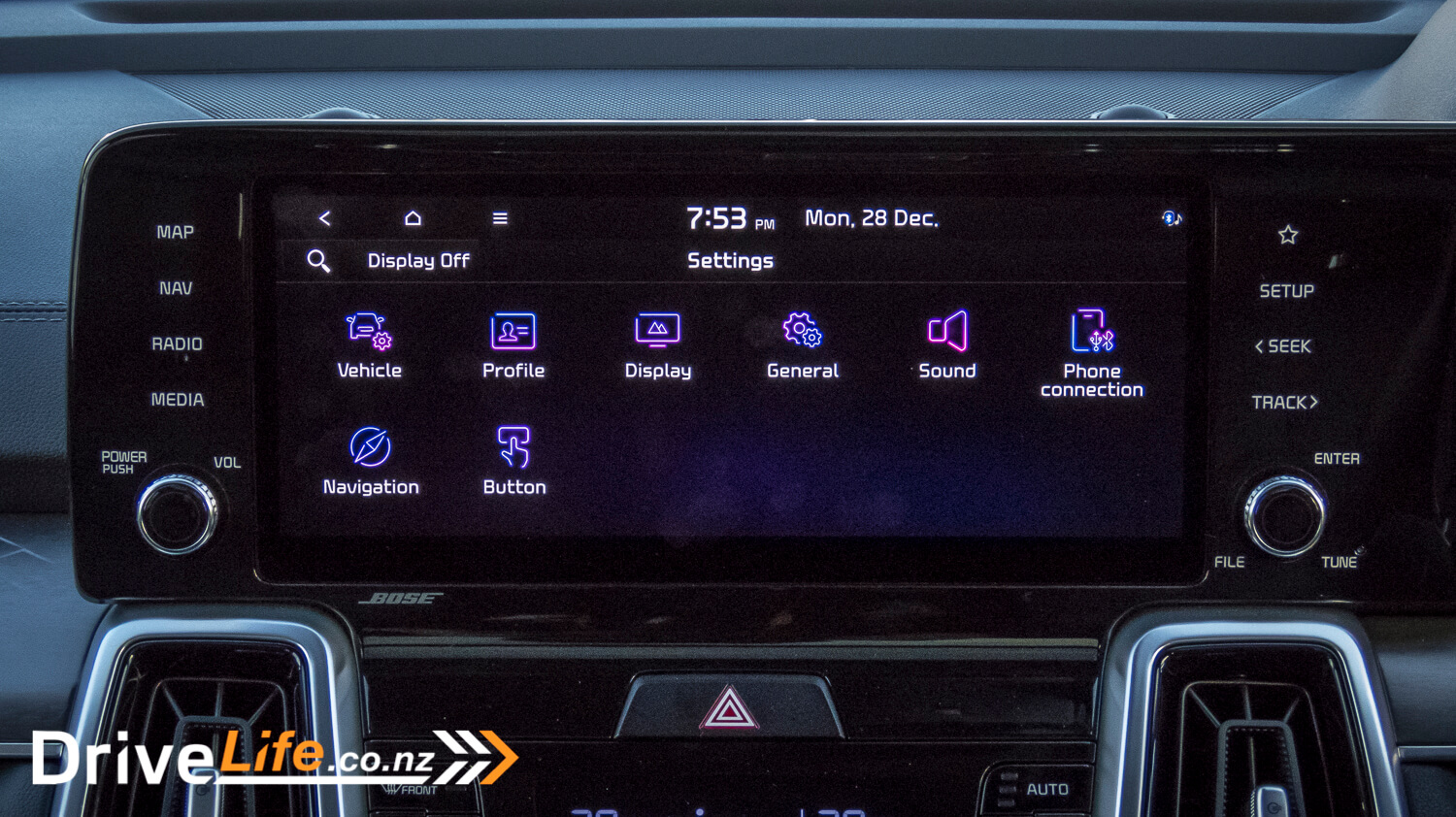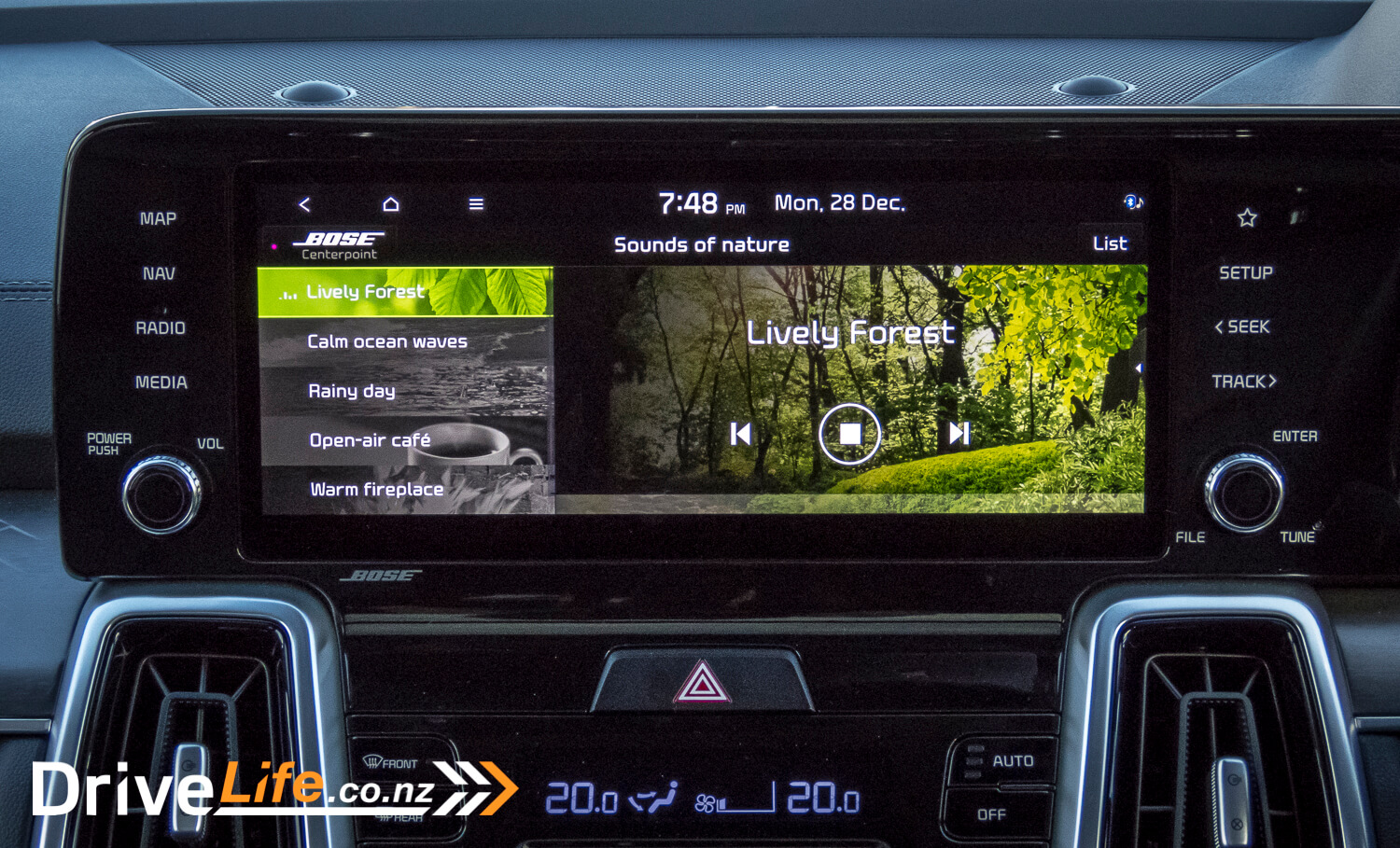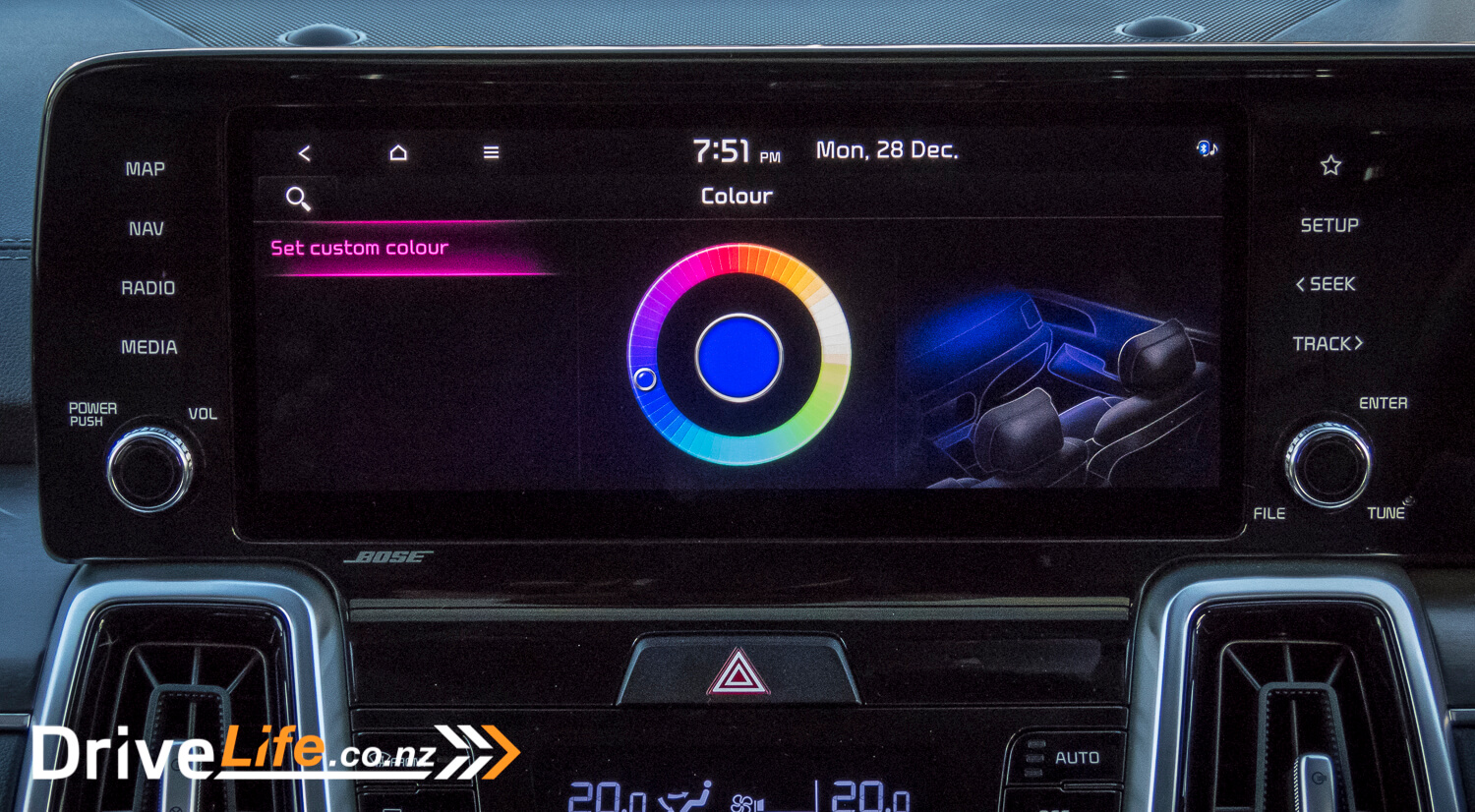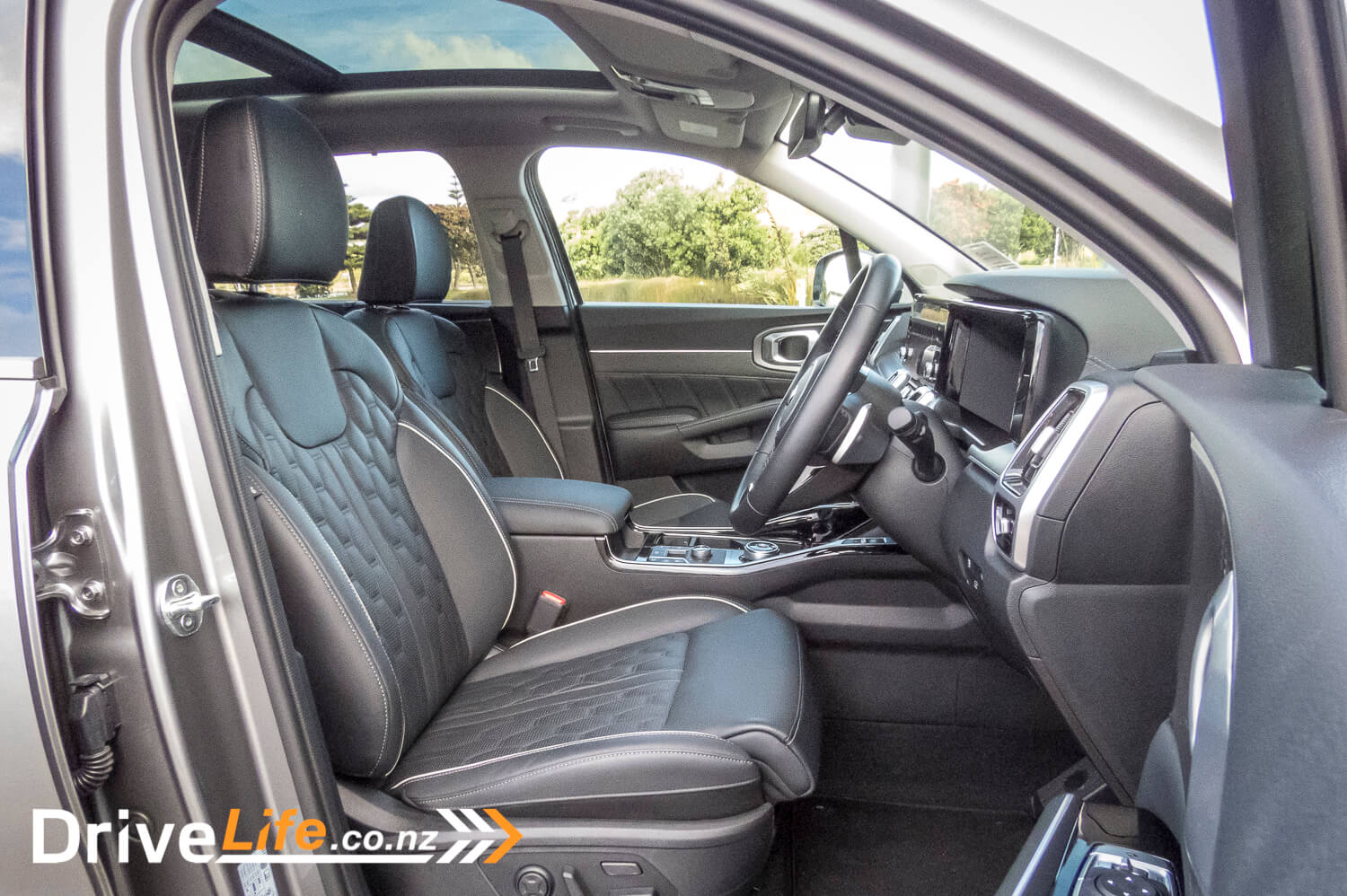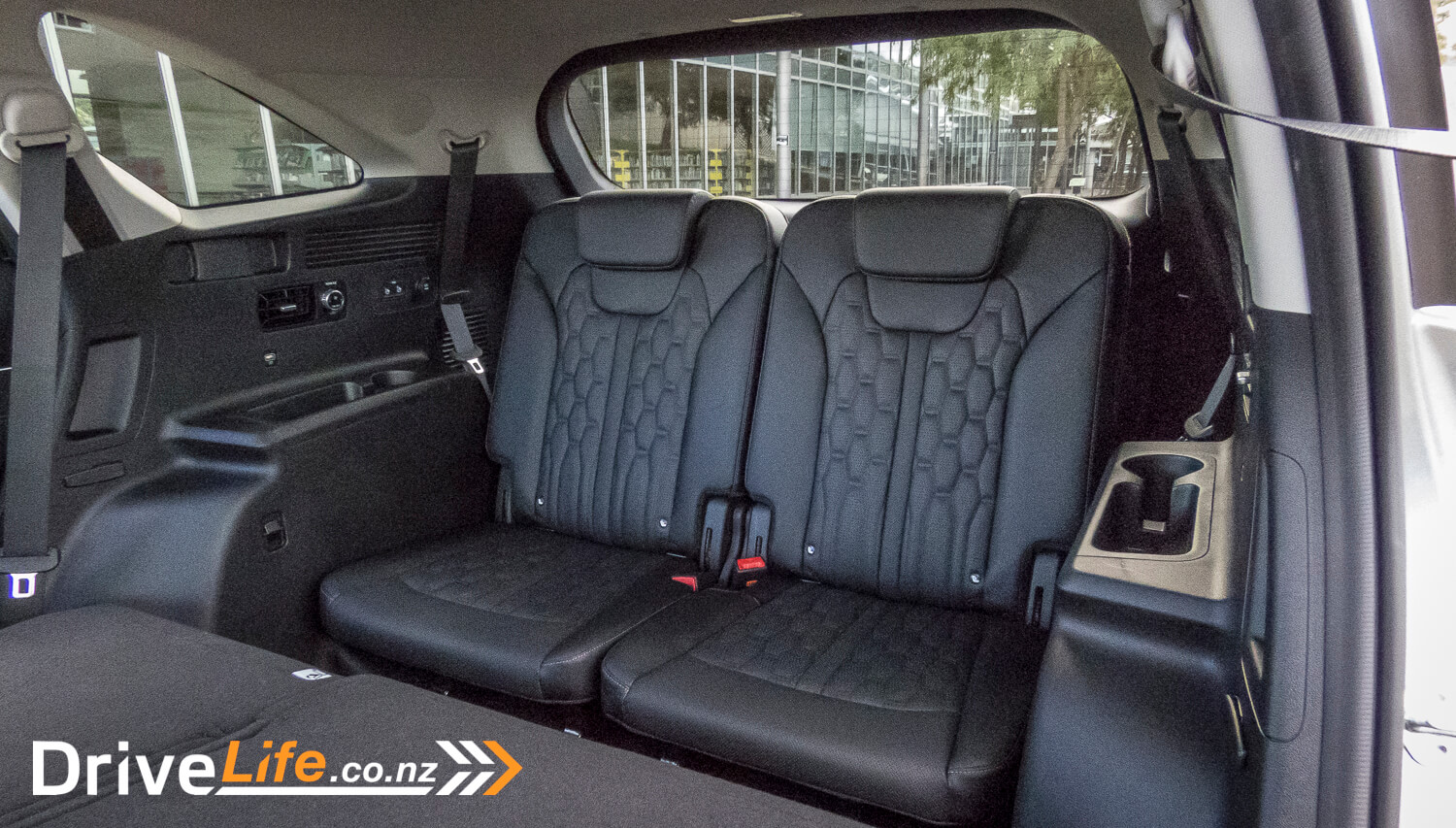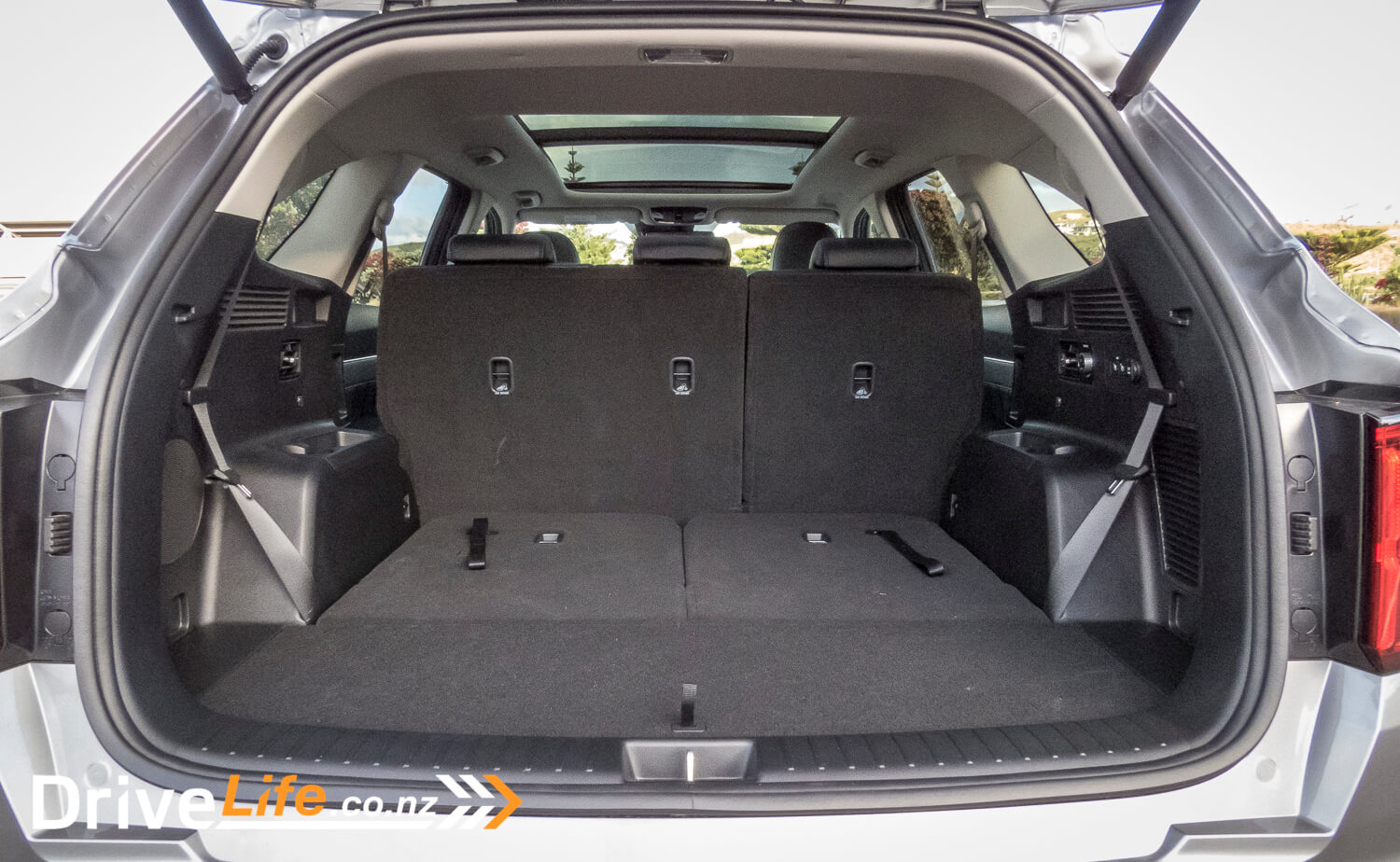Kia may seem like a relatively young brand in the minds of Kiwis. So it may surprise some that the brand first formed in 1948.
Our lack of awareness can be attributed to several factors, mainly in that Kia didn’t begin to push into the North American and European markets until the 1990’s.
Kia had mixed success in Western markets during the early dates, but introduction of the Sorento in 2002 helped the brand wedge a foot-in-the-door in Europe. As of 2005, Kia became New Zealand’s fastest growing automotive brand, and now, Kia has three models (the Stonic, Seltos and Sportage) among the top 15 best-selling vehicles in New Zealand for 2021.
So, the Sorento must have been doing something right to have reached its 19th birthday. This new Sorento marks the 4th generation of the model and represents a significant departure from its roots of a cheaper alternative to the large SUV crowd from Japan. The difference is striking; this new Sorento looks, well, lavish.
The pricing reflects this too. The new Sorento starts from $59,990, and you can pay all the way up to $90,000 for a plug-in hybrid drivetrain if you’re so inclined.
So, does the new Sorento signal a new direction for Kia? Kia New Zealand gave us the keys to see what the fuss is all about.
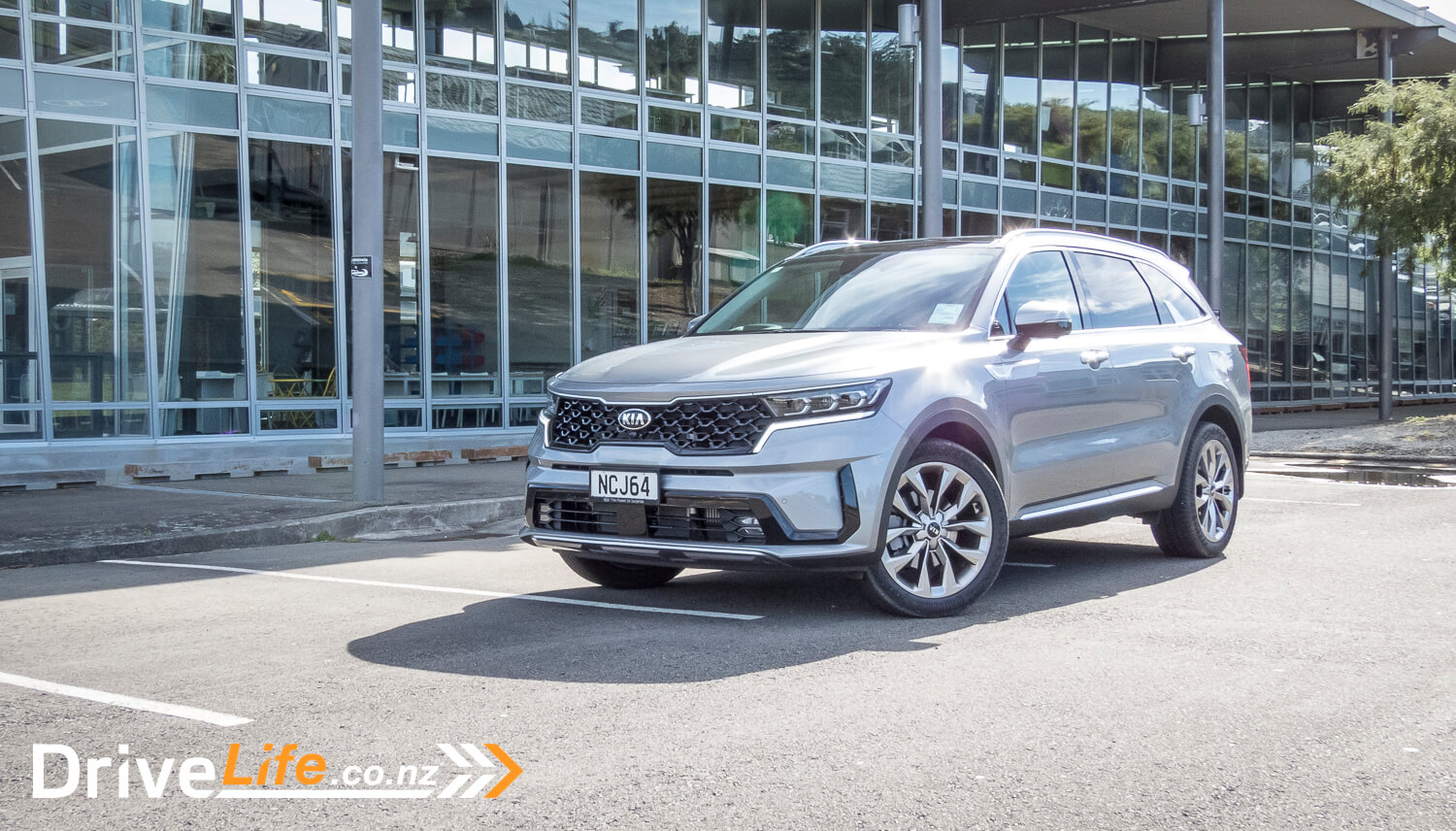
What’s In The 2021 Kia Sorento Range?
This new Sorento marks the 4th generation of the model. It’s a new design for 2020, and is built upon the Hyundai-Kia N3 platform. The N3 platform is shared with the Hyundai Santa Fe, as well as the Kia Carnival.
The Sorento is traditionally the sibling of the Hyundai Santa Fe, and shares core pieces between the two vehicles.
Kia appears to be making a big play for the New Zealand market, with up to 10 variants of the Sorento available. This includes a range of diesels, petrol-hybrids and a plug-in hybrid (PHEV) option. These are priced below;
| Model | Engine | Drive | Price |
| LX | 2.2-litre Diesel (148kW/440Nm) | AWD | $59,990 |
| EX | 2.2-litre Diesel (148kW/440Nm) | AWD | $63,990 |
| Deluxe | 2.2-litre Diesel (148kW/440Nm) | AWD | $69,990 |
| Premium | 2.2-litre Diesel (148kW/440Nm) | AWD | $76,990 |
| EX | 1.6-litre Petrol Hybrid (169kW/350Nm) | 2WD | $63,990 |
| EX | 1.6-litre Petrol Hybrid (169kW/350Nm) | AWD | $65,990 |
| Premium | 1.6-litre Petrol Hybrid (169kW/350Nm) | 2WD | $80,990 |
| Premium | 1.6-litre Petrol Hybrid (169kW/350Nm) | AWD | $82,990 |
| EX | 1.6-litre Petrol Plug-In Hybrid (195kW/350Nm) | AWD | $74,990 |
| Premium | 1.6-litre Petrol Plug-In Hybrid (195kW/350Nm) | AWD | $89,990 |
Our test vehicle is the AWD Sorento Premium Diesel.
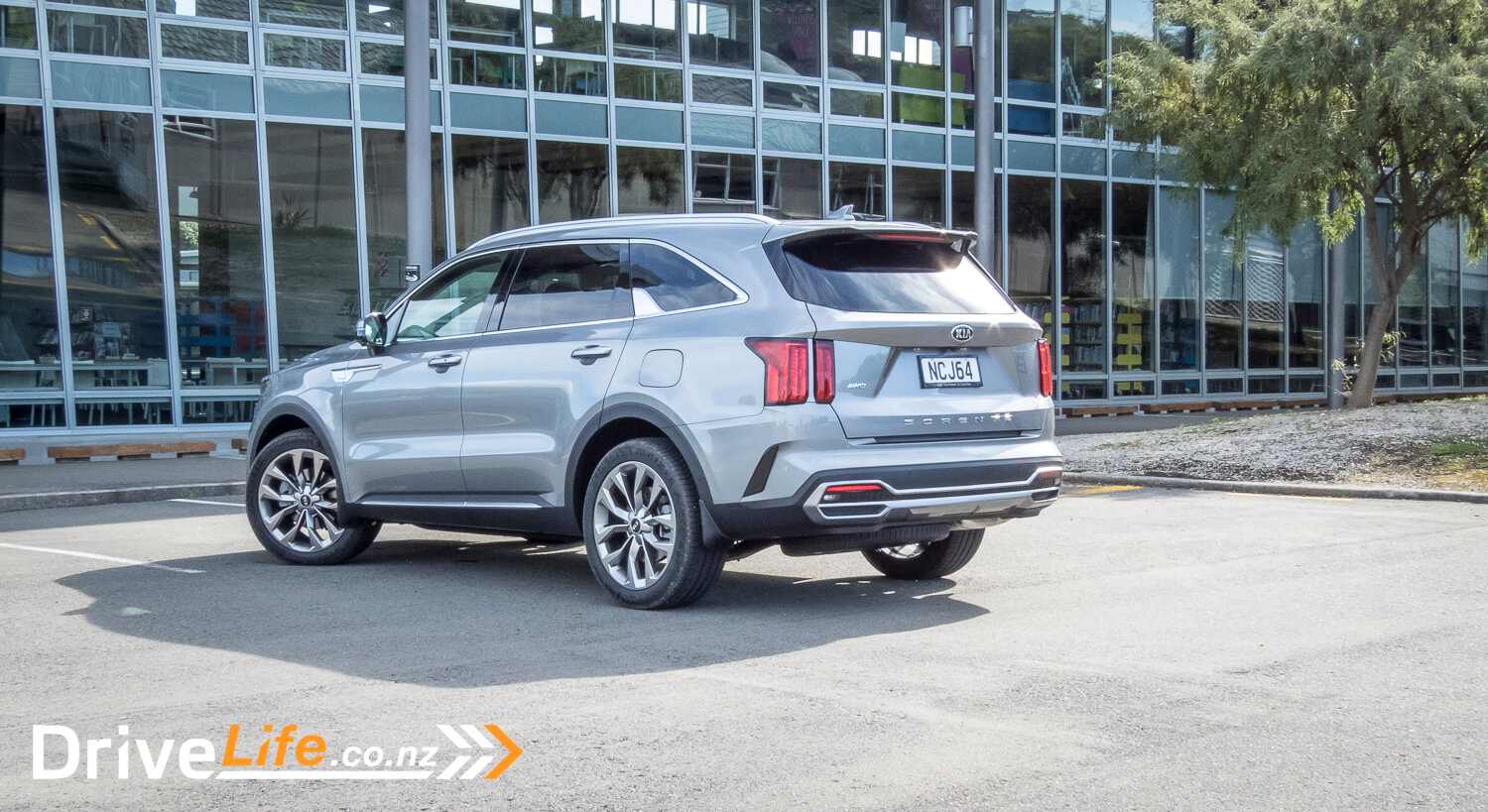
The Sorento line-up comes equipped with an array of standard features, and the Premium models tops the spec sheet. Our Sorento Premium features; 20’’ alloy wheels, 10.25’’ infotainment with Apple Carplay and Android Auto, 12-speaker Bose Premium Surround Sound system, satnav with traffic updates, 12.3’’ TFT LCD Instrument cluster, multi-colour interior ambient lighting, Qi wireless charger, around-view monitoring, Nappa leather seats, 14-way power driver’s seat with 4-way lumbar support and cushion extension, 10-way power passengers seat with 2-way lumbar support, memory drivers seat, heated and ventilated front seats, heated second row seats, passenger window sun blinds, panoramic sunroof, height adjustable tailgate, interior LED lights, front projector LED headlights, LED combination lights, auto hi-beams, auto-dimming rear-view mirror, front and rear parking sensors, alloy pedals and ION plated door handles, 7 USB ports, Rear Occupant alert, Blind Spot View Monitoring and Remote Smart Parking Assist.
It wouldn’t be 2021 if there weren’t a suite of safety features on-board. The Sorento Premium gets the works, including; Forward Collision Avoidance (car, pedestrian, cyclist and junction), multi-Collision braking, Emergency Stop Signal, Blind Spot Collision Avoidance Assist, Rear Cross Traffic Collision Avoidance, Lane Keep Assist, Lane Follow Assist, Reverse and Parking Collision Avoidance, Driver Attention Alert, Trailer Stability Assist, Hill Start Assist and Downhill brake control.
Our Sorento is powered by a 2.2-litre CRDi turbodiesel engine outputting 148kW of power and 440Nm of torque. The engine is paired with 8-speed dual clutch transmission, with a e-shift dial (shift by wire). Underneath, power is vectored through an Active AWD system (with part time lock modes).
The Sorento is offered with six different colours; Mineral Blue, Snow White Pearl, Platinum Graphite (dark grey), Steel Grey (light grey), Aurora Black Pearl (black) and Runway Red.
For more information on the Sorento line-up, visit the Kia New Zealand website.
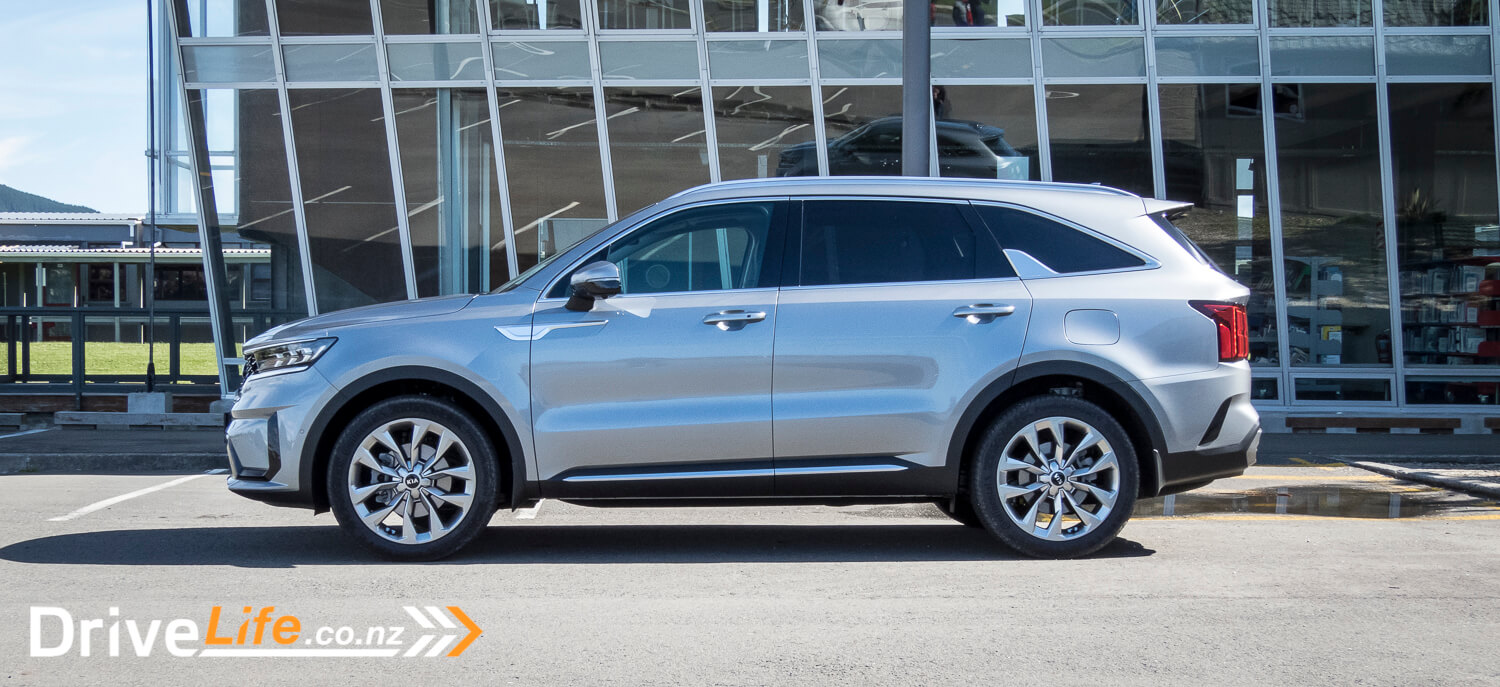
First Impressions
Compared to its Santa Fe sibling, the Sorento is undeniably the more conservative of the two.
This Sorento has the usual boxy SUV dimensions, but unlike the rounded features of the model before it, the new vehicle has re-emerged with a design with straighter lines, longer proportions and sharper edges.
Body wise, it’s fairly pleasant, but a bit strait-laced. How I would describe the exterior of the Kia Sorento is like the unexpecting fella that scrubs up well for a formal occasion.
In other words, it’s the features – not the lines – which makes the Sorento stand-out.
Up the front, there’s sharp LED projector headlights flanking a glossy ‘tiger nose’ grille. Down the side, there’s a chrome design flick on the C-pillar, breaking the dead-straight beltline. At the rear, there’s another set of sharp combination LEDs, along with a large roofline spoiler. The whole car sits on large 20’’ alloys, wrapped with even larger tyres.
Although the body style mightn’t inspire anything, all of these features really lift the presence of the vehicle. The new Sorento looks like a premium, high-end SUV.
Scrubs up well, don’t it?
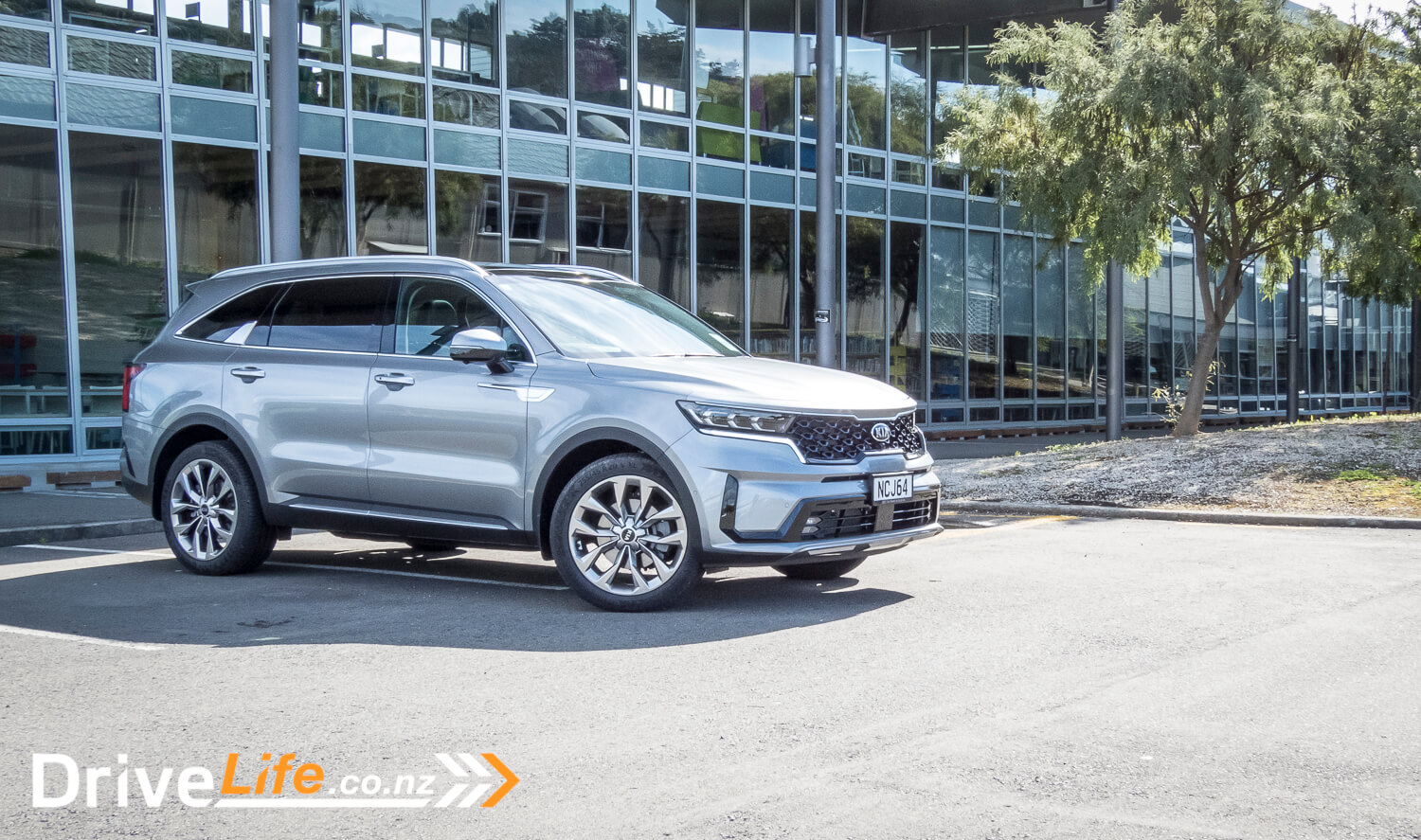
What’s the Interior Like On A 2021 Kia Sorento Premium?
Kia is producing some seriously high-quality interiors for their vehicles these days, but stigmas of older vehicles still lurk in my mind.
So, I wasn’t entirely mentally prepared for the Sorento when I first climbed in. Suffice to say, it was one of those moments where you have your expectations shattered.
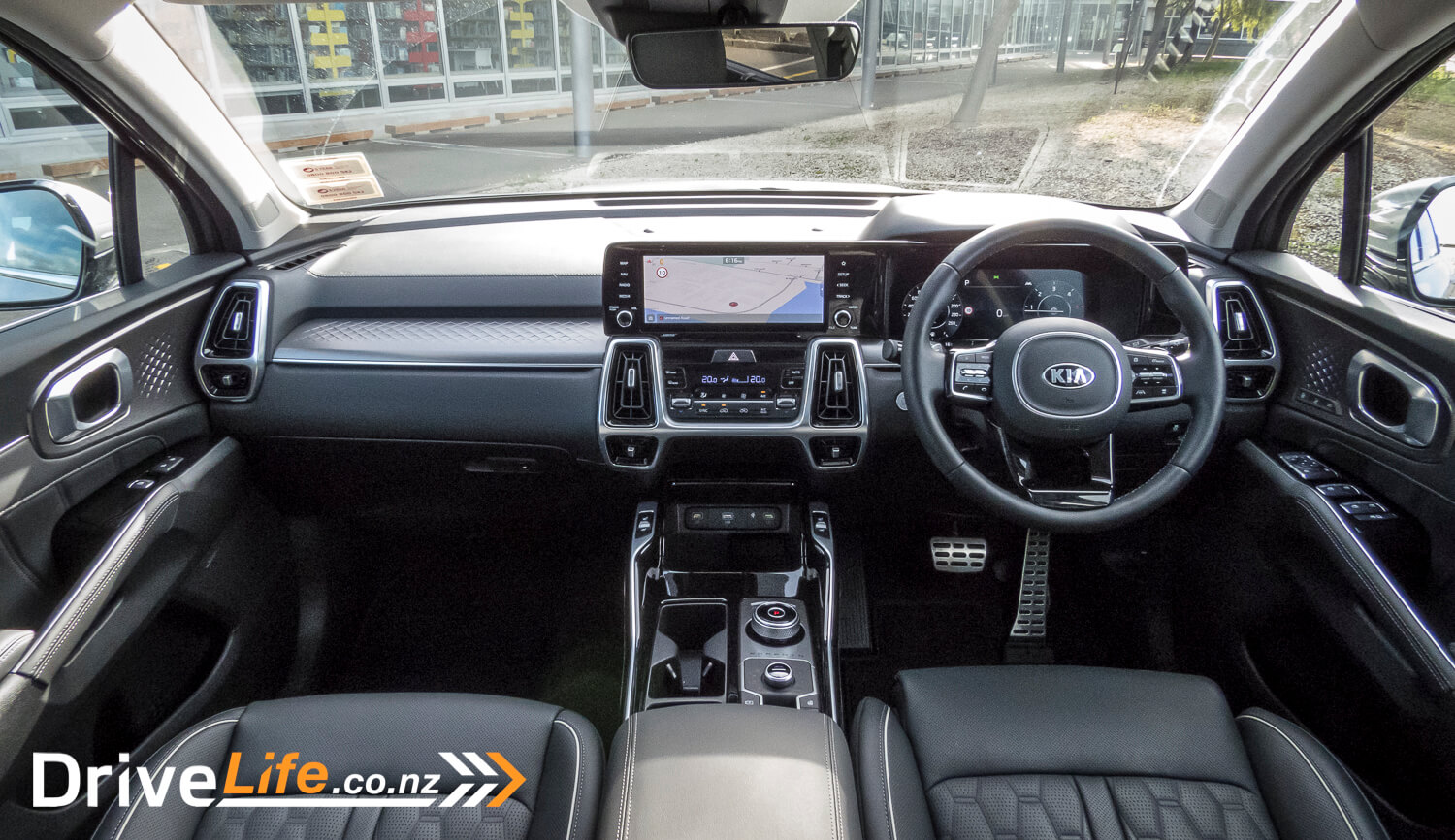
The build and material quality are excellent; there’s abundant use of leather and other soft textures across the key touch points. There are textured metal inserts across the dashboard and on the door cards, which also houses the LED ambient lighting. The door handles themselves are also metal plated.
Once your eyes start searching, you will begin to identify some hard plastics, but they’re mostly below eye level existing in the bashable areas. This is a family SUV after all.
There’s also plenty of piano black plastic trims, including around the air vents, on climate controls, and the centre console amongst other spaces. This plastic tends to mark easily, hence it’s a bit of a shame Kia put this stuff in places where you are often touching it.
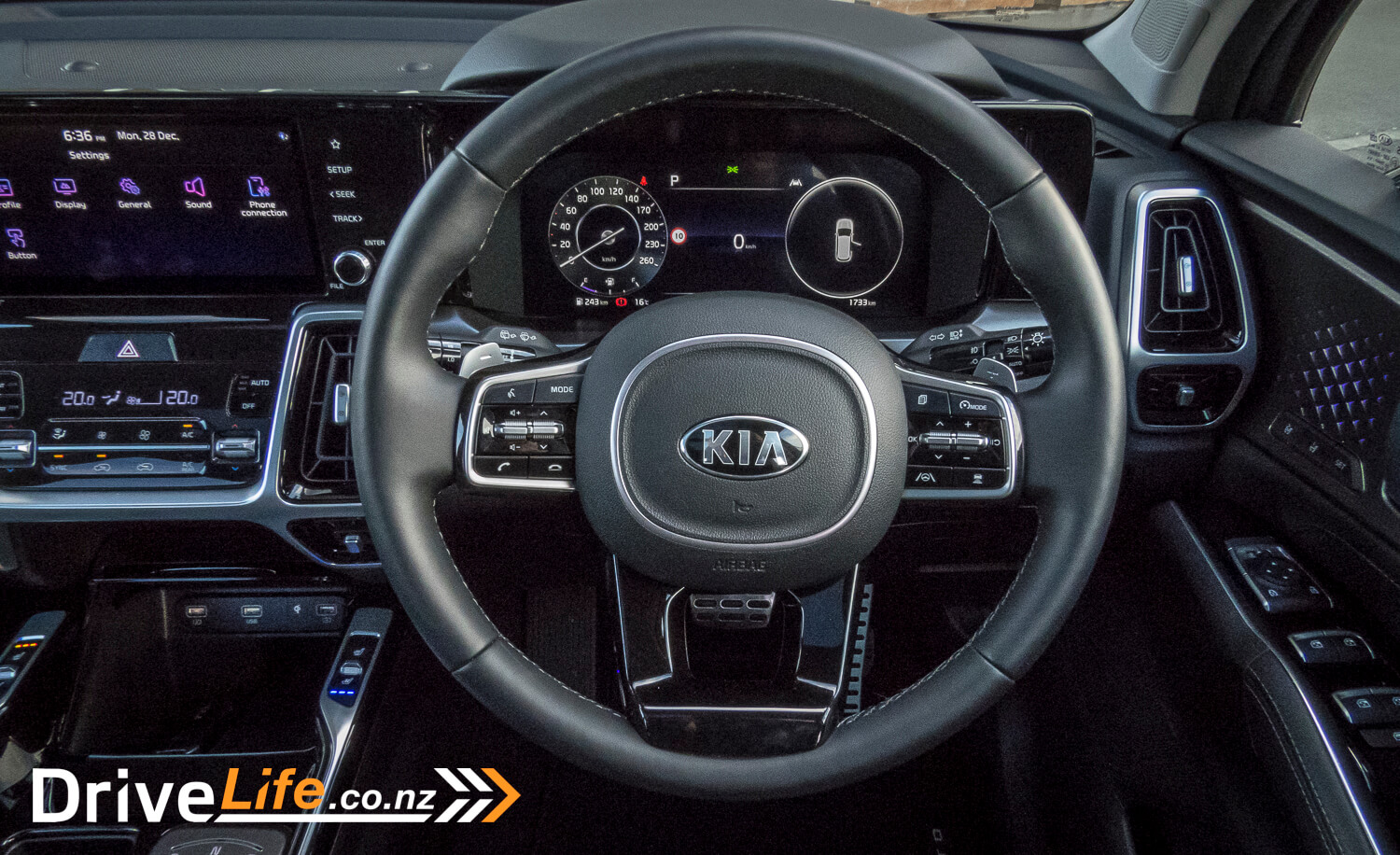
The centre console is neatly arranged with two rotary dials; the prominent silver dial for switching into drive, and a smaller one for selecting drive mode and terrain response. At 12’o’clock, there’s a cubby which houses your USB ports and a wireless charger.
Of course, the most standout feature is the facia connecting the centre infotainment and the drivers instrument cluster. The design somewhat imitates the layout used by Mercedes.
The centre 10.25’’ infotainment screen is excellent. The touch interface is highly responsive, demonstrating little lag between actions. The screen resolution, contrast ratios and refresh rates are good, and definitely of the standard that we should expect in 2021.

The system UI is the same as in other Hyundai/Kia products. It’s easy to comprehend and a first-time user should have no issues with it, which is a hallmark of a well-designed unit.
The system also has several ‘hard’ menu controls on the bezel of the screen (good!), however all of these controls are haptic touch (bad!) and the bezel is piano black plastic, meaning it’ll become very finger-printy when you attempt to get these controls to respond (ugly!).
The infotainment system is linked up to a 12-speaker Bose audio system. The overall quality should appease the casual audiophile. The system also features Bose’s Sounds of Nature. Basically, there’s a bunch of pre-programmed audio files designed to sound like certain environments (e.g. Snowy Village, Ocean Waves). I doubt many will actually use these, but it’s a fun little gimmick to show your friends.
Moving across to the driver’s instrument cluster, the display has crisp graphics and good contrast ratios. However, for a full digital cluster, the configurability is somewhat limited. The main display configurability is tied to the drive mode selector, which changes between the drive modes.
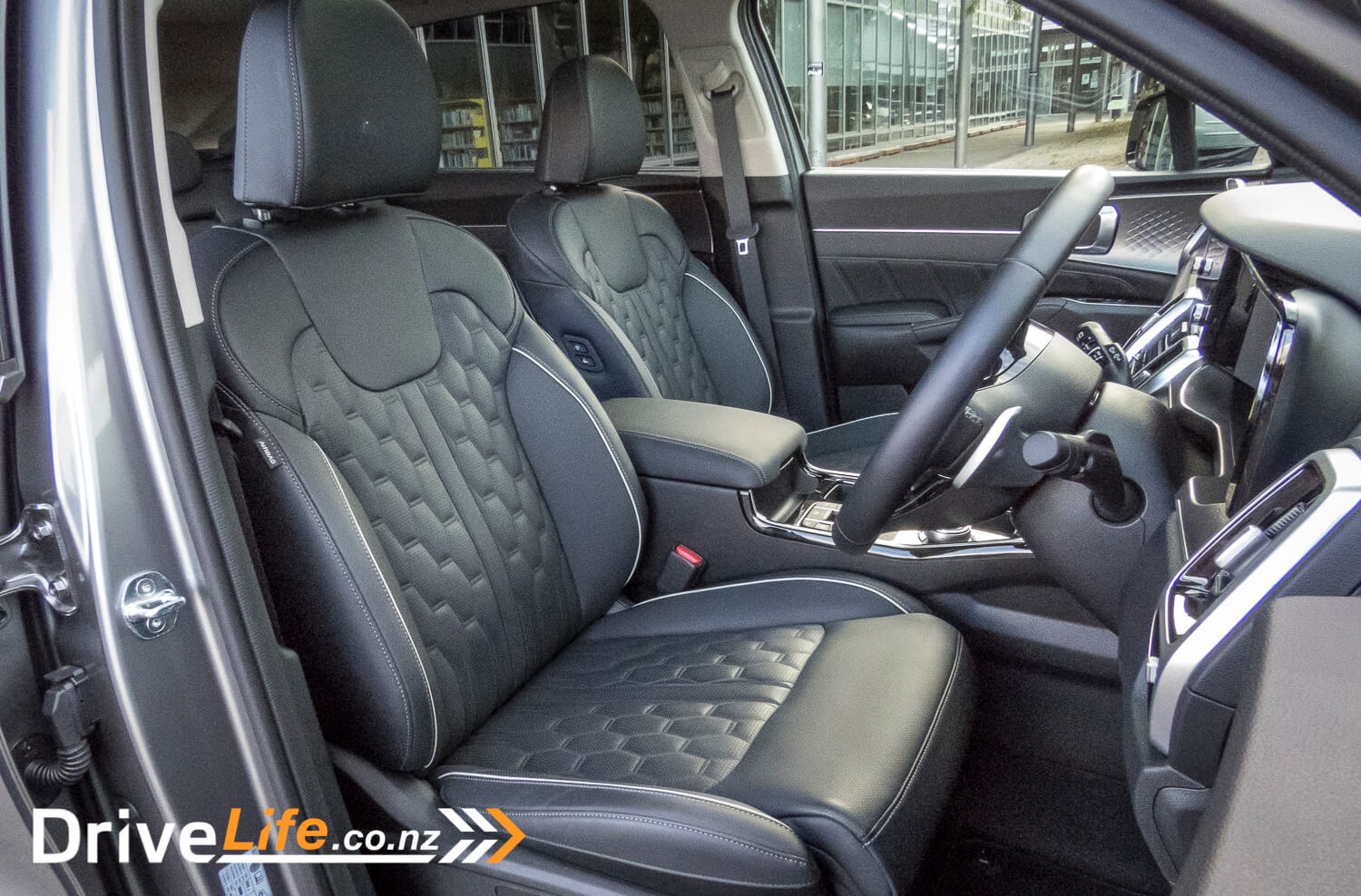
The front seats of the Sorento are easily one of its best features. In this Premium model, they’re wrapped in black Nappa leather (which essentially means they’re a soft, full grain leather), with diamond pattern and white contrast stitching. You can tell they’re premium without even touching them. Interestingly, Kia only offers this on the Premium-spec diesel, but not for the Hybrids.
Both front drivers and passengers’ seats are comfortable and hugely configurable. I was able to dial-in my lumbar support near perfectly, and there’s even an under-thigh support extension for the driver. The front seats are positioned high, giving you a commanding view out of the vehicle.
Another trick of these seats is that they offer three-stage heating and ventilation which pumps out cool air through the leather perforation. Manufacturers, please take note, ventilated seats are amazing! For those of you who haven’t had the pleasure, it’s almost like having your head on the cool side of the pillow, all-of-the-time.
Kia has also incorporated some basic adjustment controls onto the right passenger’s seat bolster, meaning you can adjust your front passenger seat from the driver’s seat.
I found this feature to be particularly useful, as fully electric seats aren’t common for all passengers yet and some struggle to figure out the seat controls. Rather than provide vague instructions, you can simply do it for them.
Of course, the controls are also within reach of the rear seat passengers. So, you’ll need to discipline the younglings in the back to not push the seat all the way forward, holding the eldest in the front to ransom.
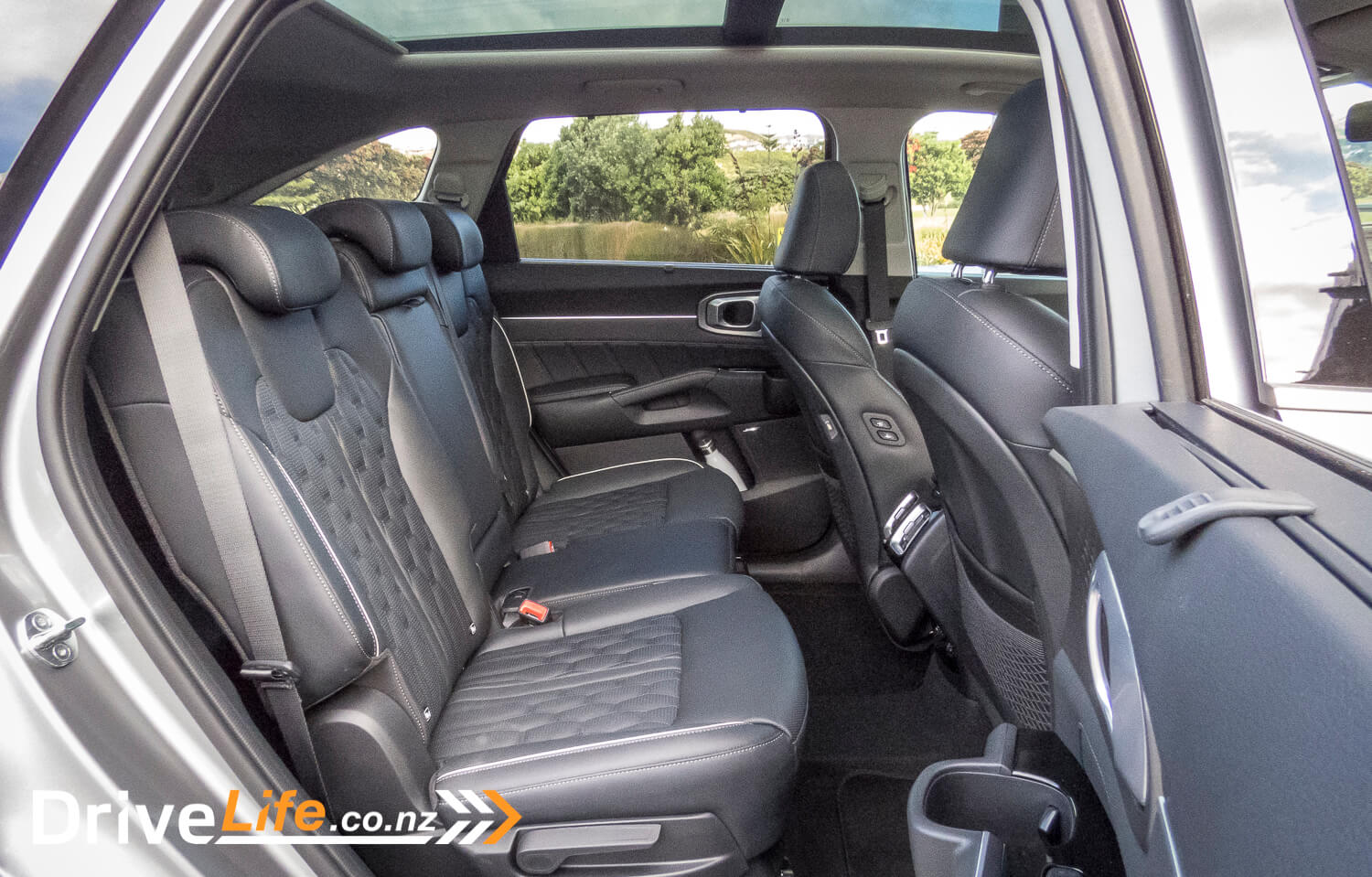
The second-row seats are also excellent. There are minivan levels of adjustability in the seats, allowing them to recline and slide forward/backwards in addition to the abundant levels of leg and headroom. This is definitely a spot to comfortably ferry adults, and that’s before we’ve discussed the amenities of the second row too!
The second-row window seats have two-stage heated seats, rear-window blinds, and a series of USB ports. The doors also feature two cup holders; one for a standard drink and another cutaway for a drink-bottle.
The third row is a slightly different story. There’s not much legroom, hence this spot will be exclusively reserved for those younger than a decade. Fortunately, they should be kept happy, as two of the seven USB ports are situated back here. There’s also some cup holders for the jungle juice too.
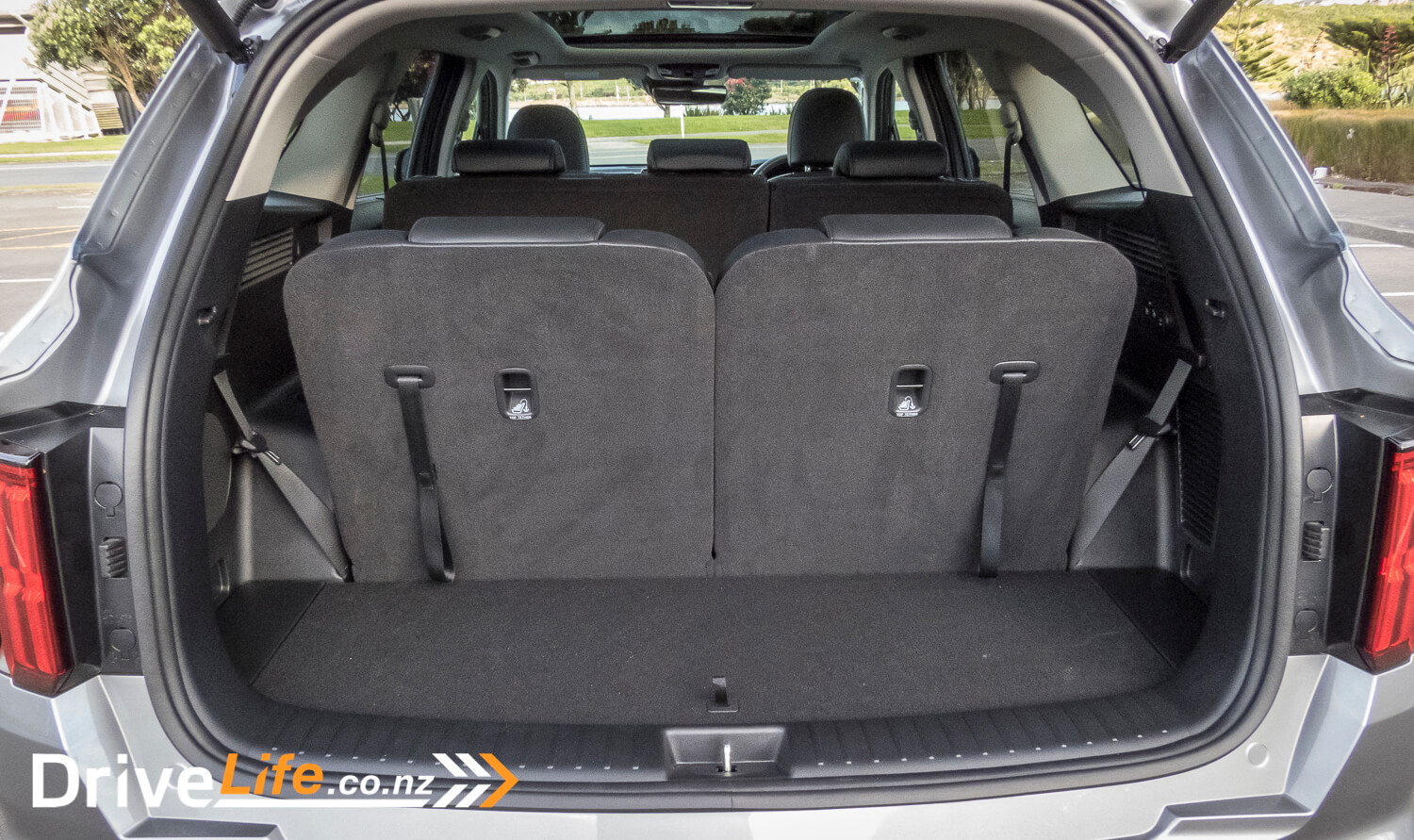
Another consideration, with the third row in place, it leaves you with a meagre 177L of boot space. A Mazda MX-5 has more boot space than that! Fortunately, the mechanism for putting the seats down is excellent. It’s a pull strap velcroed to the back of the seat, and one tug will fold the seat straight down to give you a flat floor. There’s also a button in the back to put down the second row, which is an electro-mechanical release.
Although the Sorento’s interior is largely well thought out, there are two small annoyances which impact the daily-ability of the Sorento. First-off, the driver’s door panels have a lower storage slot, but it seems it wasn’t designed to accommodate a water bottle that well. The second complaint is perhaps more specific to me, but when I drive, I tend to rest my leg against the centre console. Manufacturers know some do this, and sometimes will put a small bit of padding at knee level. The centre console of the Sorento has quite a hard edge on it, meaning it felt quite uncomfortable doing what I naturally do. Overall, the interior of the Kia Sorento is high-quality, spacious, ever-practical and hugely equipped for the price. Virtually every passenger I had voiced how impressed they were with the cabin. Aside from my dislike of haptic touch controls, small boot space with the third row in use, and that awkward edge on the centre console, there’s not much I can fault this Sorento on.
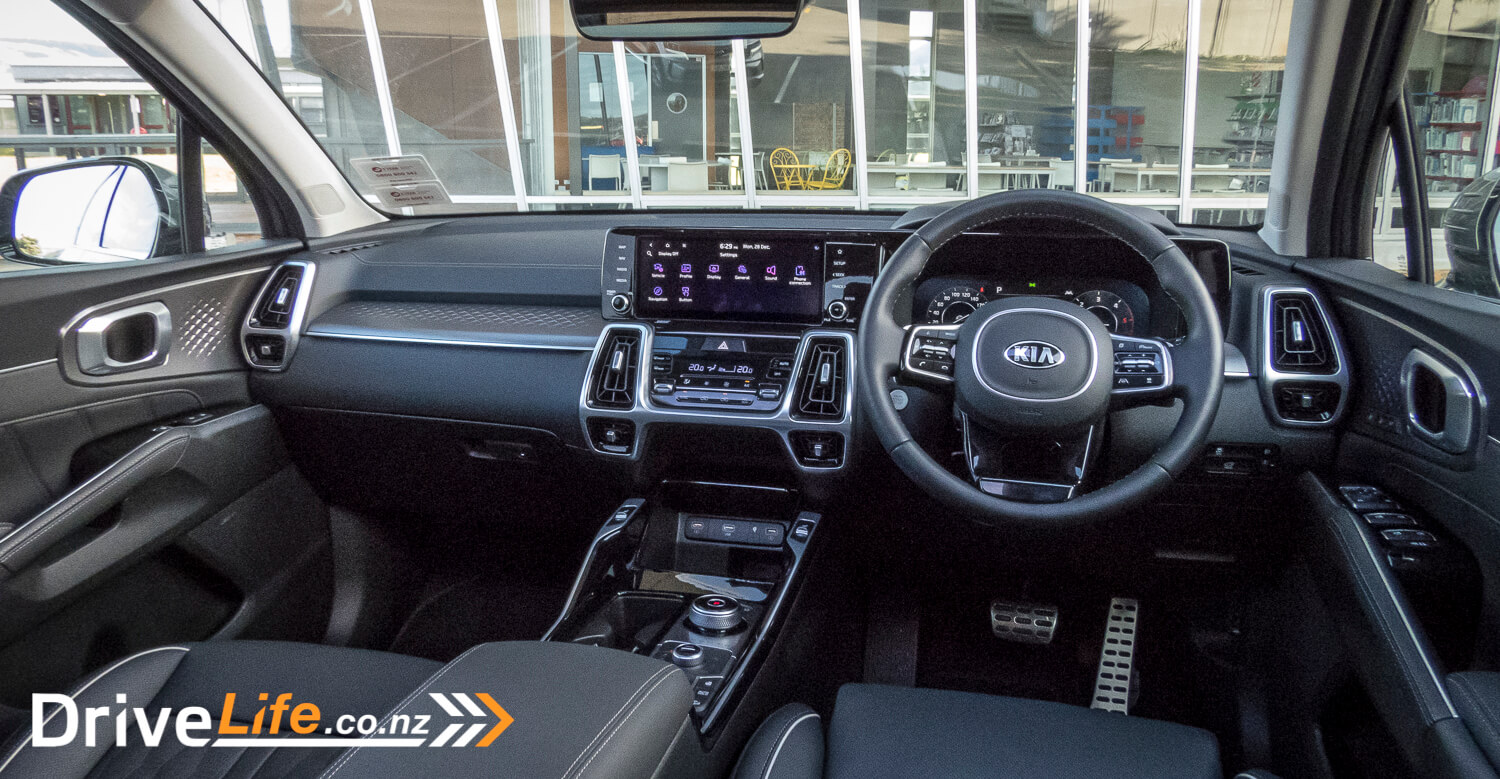
What Does The 2021 Kia Sorento Premium Drive Like?
As the years progress, the line between car and rolling computer is gradually becoming muddier. The evidence of this in the Sorento is that the car plays an introductory melody to you once you’ve climbed into the cabin. Yes, like a computer.
Before you pinch the bridge of your nose, you should be aware that most EV’s do this to tell you the car has started. Also, the Kia plays a pleasant classical number – much more complex than the start-up tune of a Windows XP. Besides, it’s relaxing! Sort-of.
Anyway, onto the serious stuff. Our Sorento is powered by a 2.2-litre CRDi turbodiesel engine outputting 148kW of power and 440Nm of torque.
This engine architecture (Hyundai R engine) has been in production since 2009, which means Hyundai/Kia has had plenty of time and millions of real-world testing miles to help with continuously improving this engine.
Judging by the performance and refinement, they’ve utilised every minute.
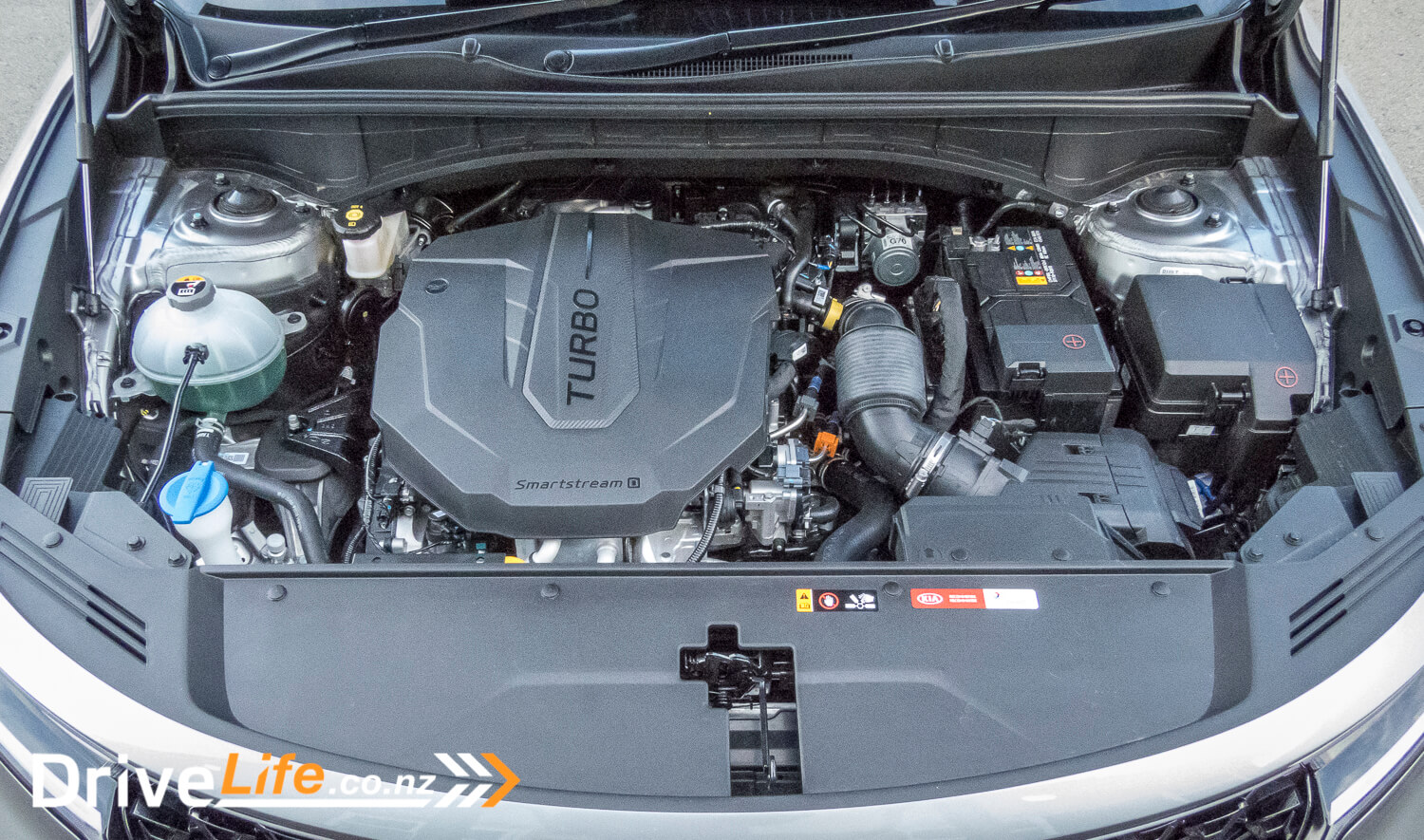
This engine is smooth and well refined, and those inside the vehicle would be pressed to distinguish that it’s a small displacement turbo-diesel engine under the bonnet. The powerband is consistent and linear with no notable turbo-lag. The torque delivery begins from near the start of the rev range, peaking at a low 1750rpm, translating into punchy off-the-line performance. The Sorento’s engine performance propels this family bus to the speed limit rather brisky. Parents, ensure juice bottle caps are secured before take-off.
Unlike some small-displacement diesels, the engine doesn’t run out of puff once you’ve exceeded peak torque. The Sorento will rev strongly till its peak power at 3800rpm, and the engine doesn’t announce itself too loudly when placed under pressure.
In short, this engine pulls strongly from a standstill and does well to maintain its wind. It does start to weaken at the top-end, but as do many other turbo-diesels. Importantly, open road passing isn’t a problem.
The Sorento’s lively performance is invariably assisted by its new 8-speed dual-clutch transmission (DCT).
In the past decade, the Hyundai/Kia group went on a hiring spree through Europe and poached some of the best to head up different divisions of the conglomerate. One might suspect their European imports brought the inspiration for dual-clutch transmissions, as they’ve found their way into vehicles all throughout the Kia line-up.
Anyway, Kia’s new DCT is a wet-clutch DCT, which is a first for the segment. A wet clutch means that the clutch packs sit in oil, which directly benefits cooling and help deliver smoother shifts.
According to Kia, their new wet clutch has a 58% improvement in maximum torque capacity over their dry clutch unit, along with 3% fuel efficiency gain – don’t spend it all at once.
In practise, the Sorento’s DCT shifts seamlessly when you’re on the move. Even at low speeds, the gearbox was mostly well behaved, but as is the case with any DCT, it can be a little bit jerky and slightly indecisive of which gear to select. Quirks aside, this DCT performed adequately in the areas where DCT gearboxes are traditionally weak.
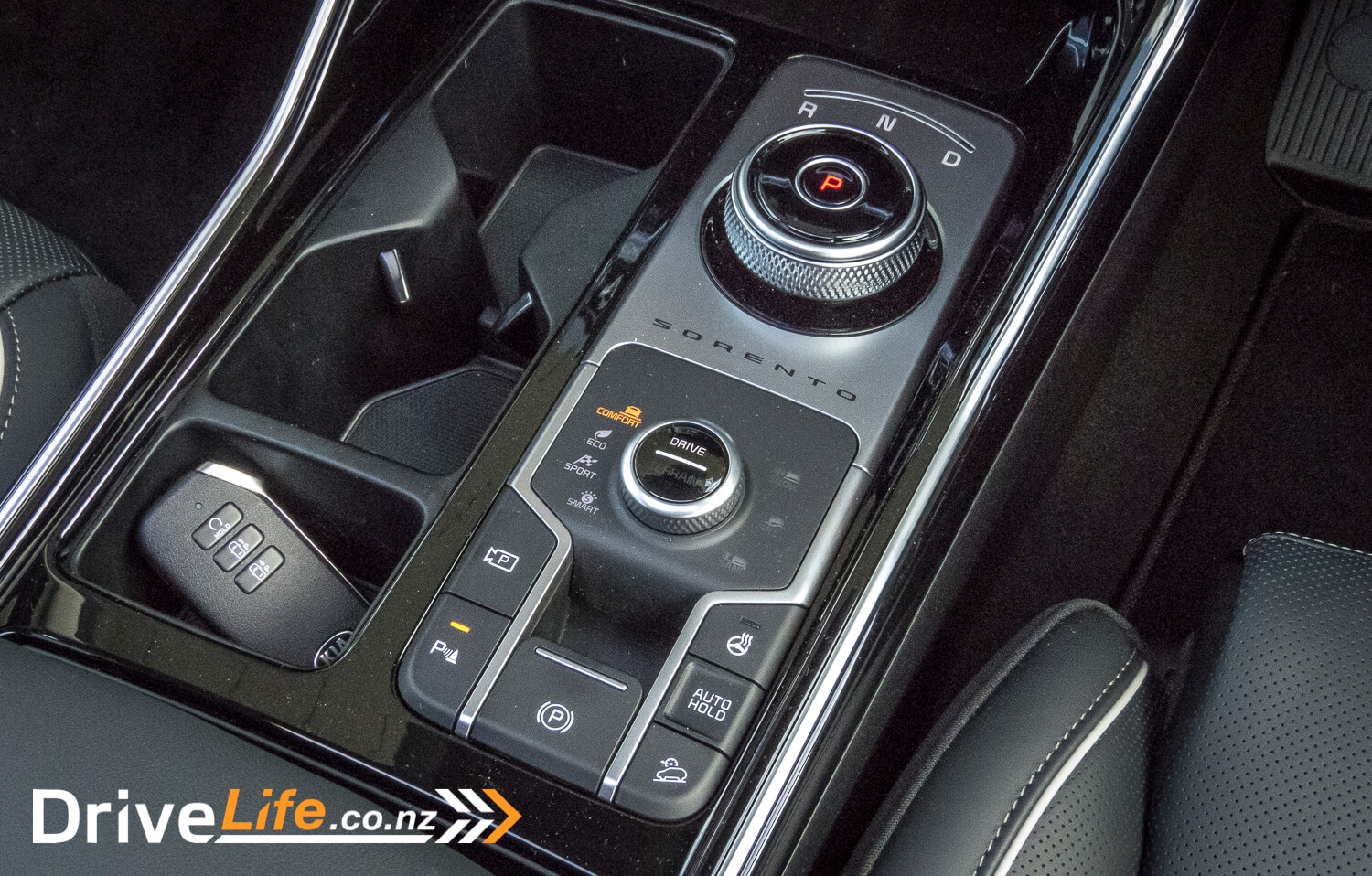
The Sorento also features a series of drive modes, which are comfort, Eco, Sport, or Smart. Each mode makes a series of minor tweaks, mainly around throttle inputs and with the steering. The major change you’ll actually see on the dashboard, where you get unique cluster displays for the different modes.
Sport mode does brighten things up a bit, to the point where a stab of the throttle will see the traction light flicker. That said, this diesel is torquey enough that the Sorento never felt sluggish in any mode, including Eco mode which dulls the throttle.
Kia has also added new Terrain modes, allowing you to select between Mud, Snow or Sand, which when selected will fiddle with the torque distribution and powertrain response. Nice features to have, but don’t expect to be climbing mountains in the Sorento.
Tarmac is definitely the home of the Sorento, more specifically, the open road. Trundling along at motorway speeds, the Sorento rides comfortably supported by its tyre of choice, the Continental PremiumContact 6. One might suspect that when the road quality shifts from Auckland motorways into windy, patchy Northland state highways that driving dynamics turn into a bowl of custard. Maybe for other SUVs, but not so with the Sorento.
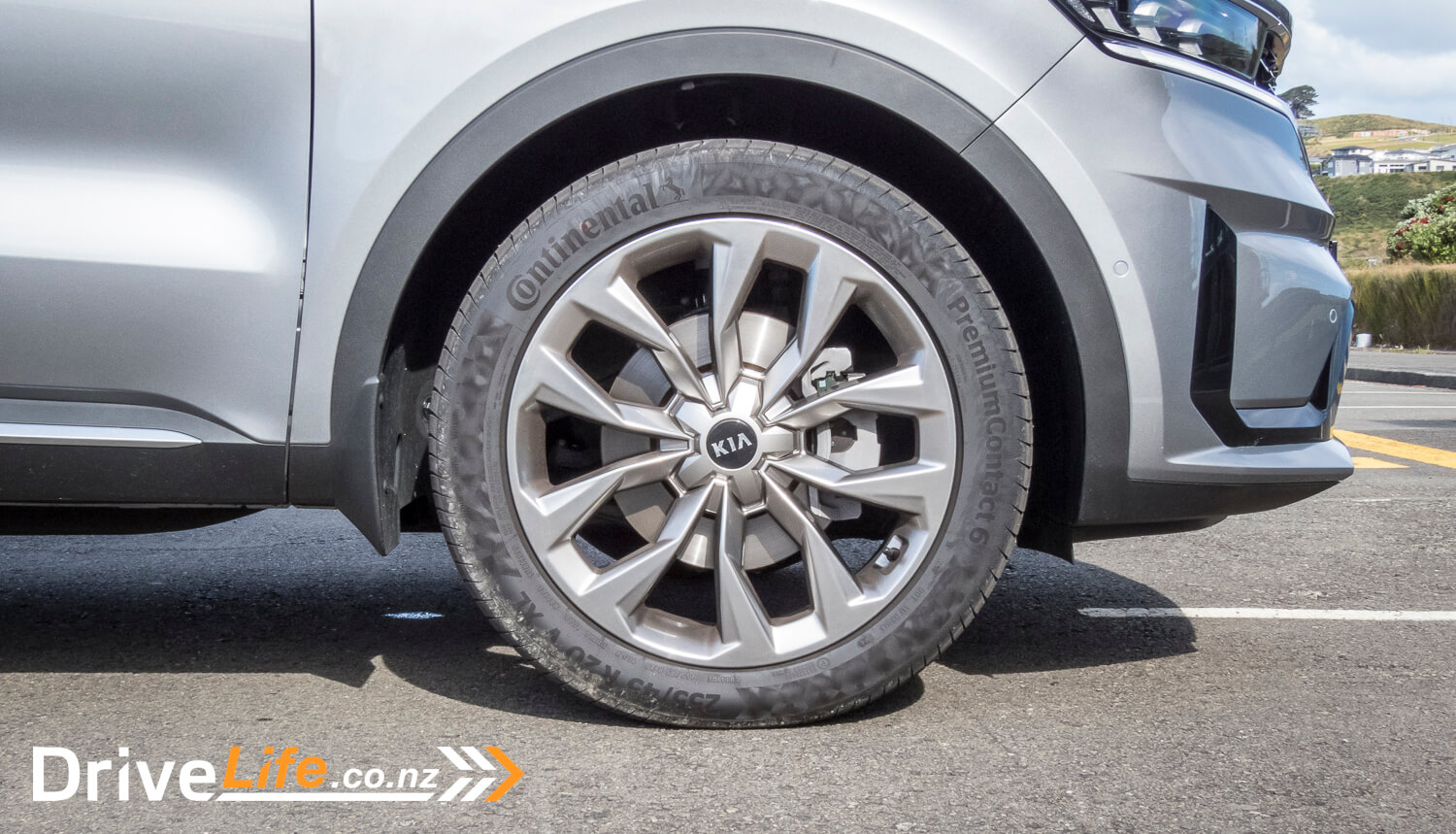
The Sorento managed its mass remarkably well. A twisty road didn’t upset it, and it would remain reasonably composed through a faster than average corner, introducing less body roll than expected. The PremiumContact 6 tyres invariably help keeping it stuck to the ground, but this is at the compromise of some tyre noise in the cabin at motorway speeds.
Surprisingly, city driving wasn’t up to the same standard. Around town, the Sorento does wobble a bit more than it should going over bumps at city speeds, meaning you’ll occasionally notice some suspension travel and relatively slow rebound. Granted, the Sorento was easy to drive through the city despite its size, assisted by its relatively tight turning circle of 11.6m.
Another area where the Sorento impresses is with the amount of technology it has on board. Of course, a comprehensive tech list is nothing without good real-world calibration and useability.
Thankfully, most of the technology inside the Kia was well optimised. The Adaptive Cruise Control operated with smooth inputs and works down to a halt. The lane-keeping assistance and self-steering also worked reliably. We’ve seen many mixed results with this technology, but in the Sorento, it worked well.
There’s a feature that may have caught your eye earlier in this review called Remote Smart Parking Assist. It’s the same as what Tesla calls the ‘summon’ mode. Yes, this Kia does it too.
Basically, it allows you to turn on the car with the key fob and start creeping the car forward from outside the vehicle! Again, I suspect this feature will be used mainly to show-off to your friends. However, it can come in handy if you’re trying to get out of a tight car park. Or similarly, attempting to park an inconsiderate motorist in (not that I’d condone such things). Interestingly, this feature is also exclusive to the Premium Diesel.
Another trick tech feature in the arsenal is Hyundai/Kia’s Blind Spot View Monitoring system. Flick on an indicator, and a blind-spot camera will display on the dashboard.
I’m a habitual head-checker, so I didn’t often use this feature. However, judging by the number of vehicles that I’m still invisible to on my motorcycle, I welcome anything that will help a driver with this, even if it’s adjusting for lazy behaviour. Also, don’t worry, you can still see your digital speedo with it on.
During our time with the Sorento, we achieved an overall fuel economy result of 8.4L/100kms, from a blend of urban and highway commuter miles. If you spend more time on the highway, it was easy to nurse the Sorento down into the low 7L range.
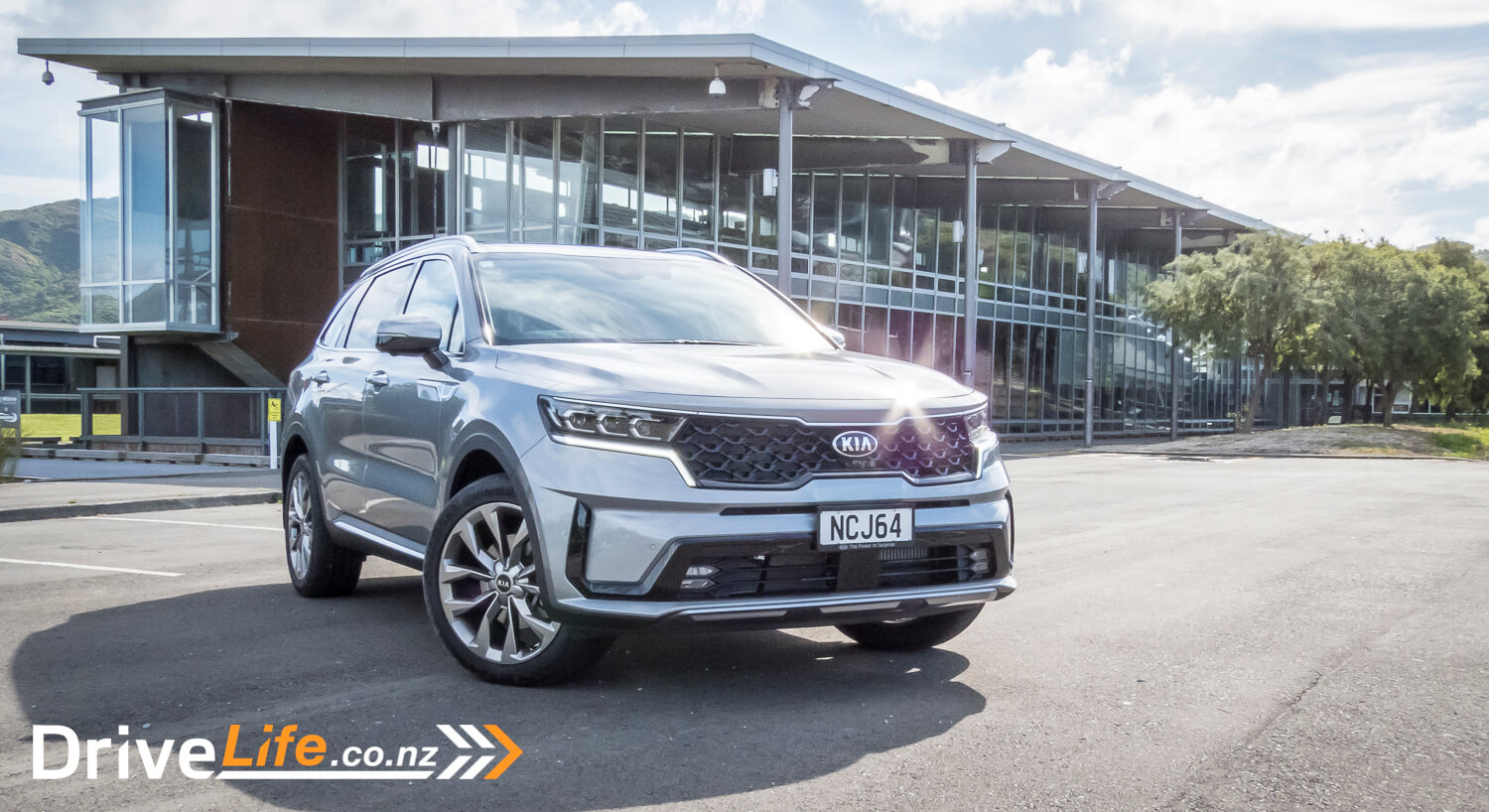
What’s The Competition For The 2021 Kia Sorento Premium?
The title of this review has a dual meaning. The obvious one is that the Sorento is an impressive SUV. The second, and personal meaning for me, is that my grandmother was visiting when I had this vehicle on test. She was blown away by all the features in this techno-bus. She actually wouldn’t shut-up about it…
Anyway, here are your primary competitors:
| Brand/Model | Engine | Power (kW)/Torque (Nm) | Fuel, L/100km (claimed) | Seats | Boot Space, Litres | Towing Capacity, Kg | Price Highest to Lowest |
| Volvo XC60 T6 R-Design AWD | 2.0-litre turbo-supercharged petrol | 246/440 | 8.0 | 5 | 635 | 2,100 | $92,900 |
| Hyundai Santa Fe Limited AWD diesel | 2.2-litre turbo diesel | 148/440 | 6.1 | 7 | 571 | 2,500 | $89,990 |
| Isuzu MU-X AWD | 3.0-litre turbo diesel | 140/450 | 8.3 | 7 | 1119 | 3,500 | $80,990 |
| Ford Everest Titanium | 2.0-litre twin-turbo diesel | 157/500 | 7.0 | 7 | 1050 | 3,100 | $79,990 |
| Kia Sorento Premium | 2.2-litre 4-cylinder turbodiesel | 148/440 | 6.1 | 7 | 616 | 2,500 | $76,990 |
| Skoda Kodiaq Sportline TDI AWD | 2.0-litre twin-turbo diesel | 147/400 | 5.9 | 7 | 630 | 2000 | $69,990 |
| VW Tiguan Allspace TSI R-Line AWD | 2.0-litre turbo-petrol | 162/350 | 8.1 | 7 | 700 | 2500 | $69,990 |
| Ssangyong Rexton SPR 2WD/4WD | 2.2-litre turbo diesel | 148/441 | 8.9 | 7 | 565 | 3,500 | $67,990 |
| Mazda CX-8 Takami AWD | 2.2-litre turbo diesel | 140/450 | 6.0 | 7 | 742 | 2000 | $65,390 |
| Seat Tarraco FR 4Drive | 2.0-litre turbo petrol | 140/320 | 7.2 | 7 | 700 | 2250 | $64,990 |
| Peugeot 5008 GT FWD | 2.0-litre turbo diesel | 134/400 | 5.0 | 7 | 702 | 1500 | $62,990 |
| Toyota Fortuner Limited AWD | 2.8-litre turbo diesel | 126/224 | 7.6 | 7 | 716 | 3100 | $61,290 |
| Subaru Outback Touring | 2.5 litre horizontally opposed 4-cylinder | 138/245 | 7.3 | 7 | 522 | 2000 | $57,490 |
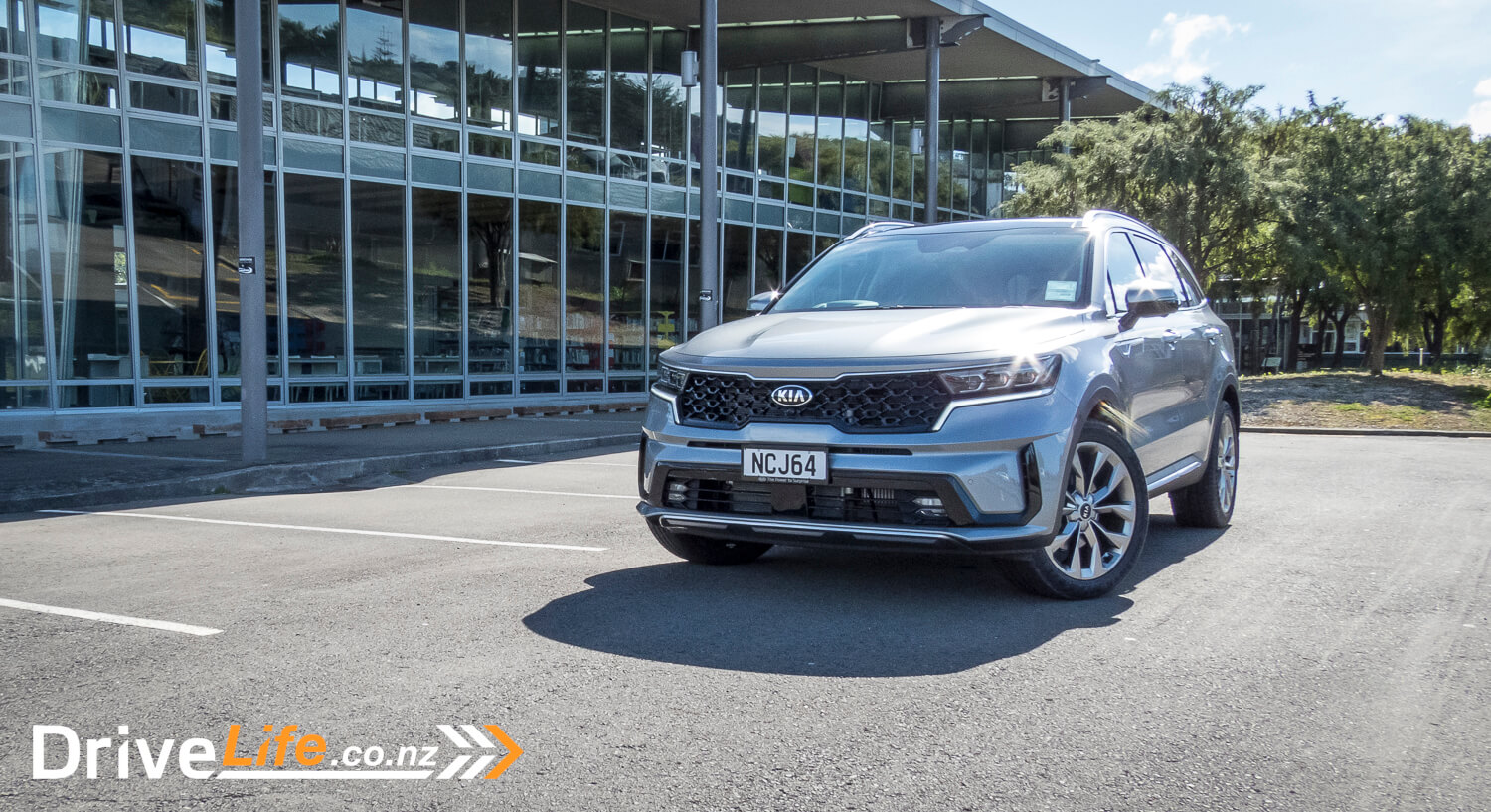
Pros
- Huge spec for price
- Engine performance – Smooth, torquey and quiet.
- Decent overall ride quality
- Quality of finish
- Well calibrated driver’s tech
- Excellent seating
- Plenty of tech tricks
Cons
- Meagre boot space with all seats in place
- Inner city ride quality could be better
- Hard edge on centre console
2021 Kia Sorento Premium – Specifications
| Price as Tested | $76,990 |
| Engine | 2.2-litre 4-cylinder CRDi turbodiesel |
| Power, Torque (kW/Nm) | 148kW@3,800rpm 440Nm@1,750-2,750rpm |
| Transmission | 8-Speed Dual Clutch Transmission (Wet Clutch) |
| Spare Wheel | Full size (Alloy) |
| Tare Weight (Kg) | 1,908 |
| Length x Width x Height, mm | 4810 x 1900 x 1700 |
| Cargo Capacity, litres | 187 (all seats up) 616 (third row down) 2011 (second row down) |
| Fuel capacity, litres | 67 |
| Fuel Type | Diesel |
| Fuel Efficiency | Advertised Spec – combined – 6.1L/100km Real World Test – combined – 8.4L/100km Low Usage: 0-6 / Medium Usage 6-12 / High Usage 12+ |
| Towing Capacity Kg, unbraked/braked | 750/2500 |
| Turning circle, metres | 11.6 Small: 6-10m / Medium 10-12m / Large 12m+ |
| Warranty | 5-year, 100,000Km 5-year Roadside Assistance |
| ANCAP Safety Ratings | 5 Star |



